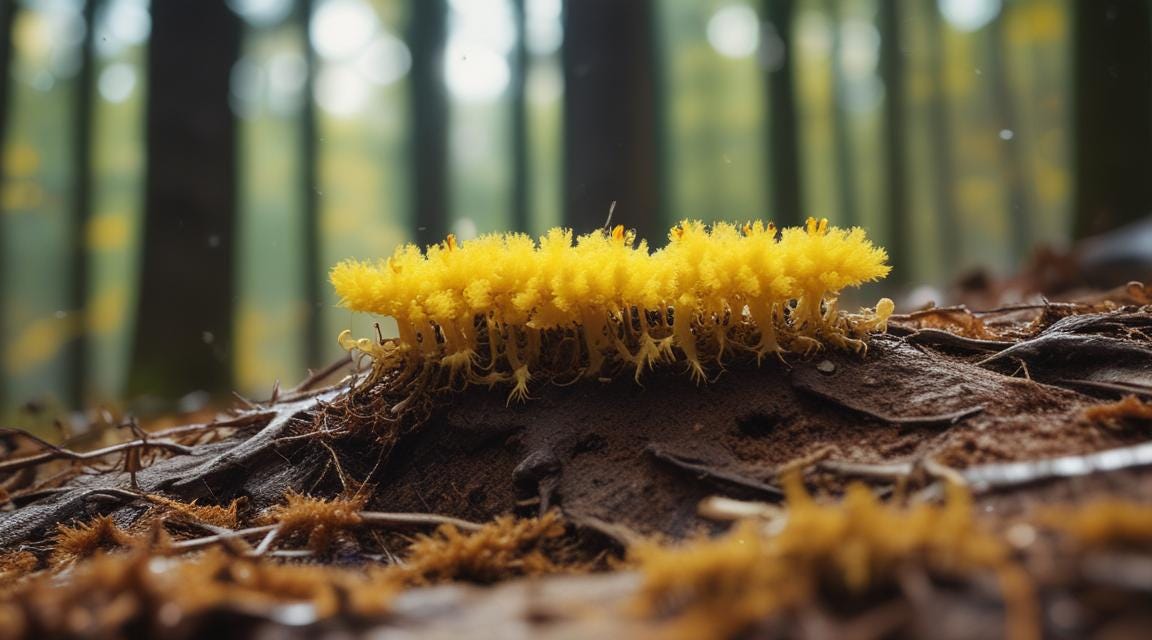117: Exploring Slime Mold Intelligence for Enhanced Earth Systems Modeling: A Thought Exercise
Today, I've embarked on a thought exercise aimed at exploring new ways to connect and model Earth's systems more effectively. In pondering the interplay between biological intelligence and advanced computational models, I’ve been particularly inspired by the navigational and problem-solving capabilities of slime mold, Physarum polycephalum. How might we harness these natural processes to enhance our earth systems modeling? This exploration invites us to consider integrating the simplicity of biological processes with the sophistication of computational systems. Let's explore these possibilities together.
Let’s dive in.
1- The Curious Case of the Thinking Slime
Imagine a scene: you’re meandering through a damp, shadowy forest. Suddenly, you spot a strange, yellow network sprawling over a decaying log. What could this be? It resembles neither a plant nor a fungus and appears to be slowly creeping along. Yes, it’s alive—exceedingly so! Meet Physarum polycephalum, commonly known as slime mold.
This peculiar ‘slime’ is deceptive; despite its simple appearance, it boasts the ability to navigate mazes, optimize pathways, and learn from experience. But how does a seemingly unsophisticated organism manage such feats without a brain? This slime mold senses and reacts to its surroundings. Spotted some oatmeal? It advances. Encountered a salty obstacle? It recoils, only to reroute.
Here’s the twist: expose it to repetitive challenges, like those patches of salt, and watch as it starts to disregard them. “Oh, that again?” it seems to remark nonchalantly, a phenomenon we call habituation. But how does a creature without a nervous system adapt and learn? The answer lies in its cellular structure. Physarum is a giant unicellular organism with myriad nuclei, enabling it to process information across a vast cytoplasmic network. This network facilitates a form of cellular communication through the flux of ions and biochemical signals, somewhat analogous to how neurons transmit signals via neurotransmitters.
Suppose we repeatedly introduce salt or other non-threatening stimuli. Initially, the slime mold's cytoplasmic network responds to the osmotic changes induced by the salt, contracting to avoid the area. Over time, though, the molecular pathways adapt, reducing the response intensity. This adaptation is akin to what we might call learning—the ability to anticipate and ignore non-harmful stimuli based on repeated exposure. Intriguingly, this form of memory doesn't rely on a nervous system but rather on a distributed network of chemical changes and cytoplasmic adjustments.
Further, when facing recurring environmental patterns, like periodic cold spells, Physarum adjusts its behavior predictively. It utilizes a form of epigenetic memory—modifications to gene expression that do not involve changes to the DNA sequence itself. These changes can be triggered by external conditions and lead to alterations in the organism’s physiological response mechanisms. Essentially, the slime mold ‘remembers’ past conditions and anticipates future events, adjusting its metabolic processes accordingly to optimize survival.
Now, you might be wondering, "How can a single cell do all this?" That's exactly the question that's going to drive our exploration. How does Physarum polycephalum, this brainless wonder, manage to exhibit such complex behaviors?
To answer this, we’re going to have to dive deeper. We need to look at how this organism is structured, how it processes information, and how it makes decisions. Are you ready to explore the inner workings of this fascinating creature? We'll zoom into the microscopic details of its biological machinery, examining the pulsing life at the heart of its cellular operations, before pulling back to appreciate the organism as a cohesive, functioning whole. Let's delve into the symphony of slime in the next part, where we'll explore how the cellular components coordinate their dance to create the marvel of decision-making without a central brain.




